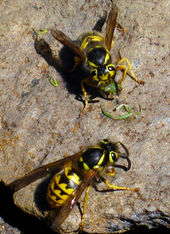
Adult yellowjackets consume only nectar. But they kill or scavenge prey to deliver needed protein to their growing broods.
"They basically just carry it in their mandibles - you see them flying with their balls of meat," said lead study author Erin Wilson, who just finished her Ph.D. at the University of California, San Diego.
In their native habitat in the western U.S., the wasps die off in winter. But in Hawaii the wasps survive the winter, possibly due to mild year-round temperatures or subtle genetic changes.
A longer life-span gives the insects more time to build up their nests. So what would normally be a basketball-size nest can become, at the extreme, several feet long - big enough to fill the back of a pickup truck, Wilson said.
The extra room allows a colony of 50,000 workers to explode to 500,000 or more. Larger colonies mean that the insects deplete more prey than in areas where the wasps die off in winter.
Picnic Pests
Western yellowjackets - best known as picnic pests - were accidentally introduced to Hawaii during the 1900s, with the last wave of arrivals, in the 1970s, coming from the U.S. Pacific Northwest.
To learn more about the invaders' impact, Wilson and colleagues studied ten colonies in two national parks where the wasps are now widespread: Hawaii Volcanoes on the Big Island and Haleakala on Maui.
The team collected bits of food from the jaws of 50 wasps and ran DNA analyses to determine what the insects had eaten.
Wilson had guessed that the aggressive bugs mostly go after slow-moving caterpillars and other "big, gooey organisms" and don't bother with many other types of prey.
The introduced wasps' taste for flesh shocked her - the insects' prey spans 14 taxonomic groups of animals, including tree lice, spiders, rats, and geckos.
Although the wasps don't kill larger animals such as birds and lizards, they do scavenge them, the team reports this week in the journal Proceedings of the National Academy of Sciences.
In addition, the adult wasps collect huge amounts of nectar, draining resources for native insects and birds such as the Hawaiian honeycreeper.
The wasps' hunger for nectar may even be disrupting pollination of native plants, the study authors write.
Overall, the wasps have been filling in the role of top insect-eater, left open as Hawaii's bird populations dwindle.
But Wilson said that prey insects can easily rebound if yellowjacket nests are removed.
Spiders and caterpillars that had been locally wiped out have returned within a few months when nearby wasp nests were taken out, Wilson said.
Pioneering Method
Picking apart the wasps' "little masticated balls of prey items" and analyzing their molecular structures was an important part of this study, said P. Kirk Visscher, an associate professor of entomology at the University of California, Riverside, who studies social insects.
"It's one of the earlier applications of this [technology, and a] nice demonstration of what it's capable of doing," he added.
Without the DNA work, the researchers would not have been able to identify the precise species that the wasps were collecting.
But according to Visscher, yellowjackets eat pretty much anything in their native habitats, so their wide-ranging Hawaiian diet is "not very surprising."
"Straight for the Head"
Even with an expanded Hawaiian menu, the wasps' vicious killing strategies haven't changed in their new habitat, lead study author Wilson said.
"If you have something like a caterpillar, they'll take their time a bit more, jump on it, and cut it into pieces," Wilson said.
"If you have something that can fight back, like a honeybee ... then they go straight for the head," decapitating the bee to disable it.
"The honeybee will still be moving - it's pretty gruesome."
And although humans aren't exactly on the menu, Wilson has been a target of the aggressive insects during her fieldwork.
"You always get stung," she said. "They can sense any heat that's escaping from your [bee] suit, and if you have a tiny little hole, they'll get you."



Reader Comments
to our Newsletter